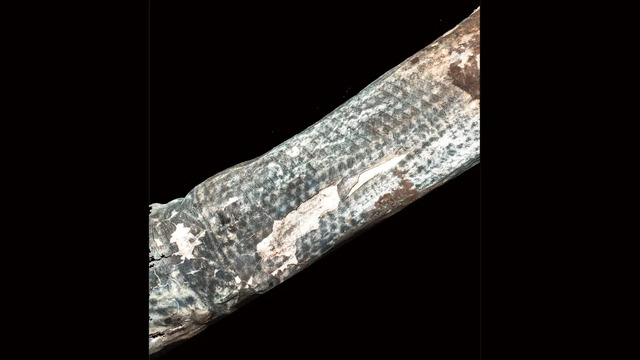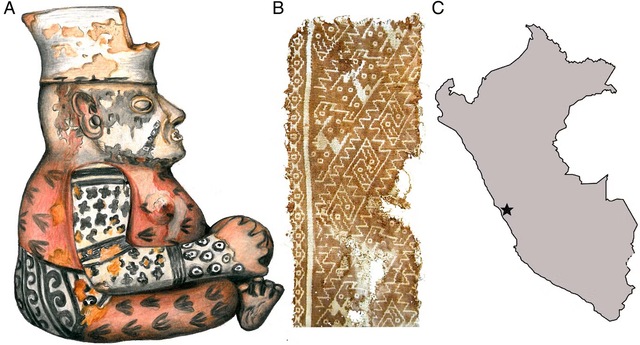Tattooing is one of humanity’s oldest art forms, serving as a means of identity, status, and spiritual significance across cultures. While many ancient tattoos have faded with time, a recent breakthrough using laser-stimulated fluorescence (LSF) has revealed hidden body art on 1,200-year-old Peruvian mummies. This discovery sheds new light on the tattooing practices of the Chancay civilization and offers insights into their artistic and social traditions.
The Chancay Culture and Their Artistic Legacy
The Chancay civilization thrived along the central coast of modern-day Peru between A.D. 900 and 1533, known for their intricate pottery, textiles, and decorative motifs. Their artifacts, often adorned with geometric designs and animal depictions, highlight their artistic sophistication. Despite their rich material culture, little has been known about their social structures and personal adornments—until now.
Tattoos have long been speculated as an integral part of Chancay identity, possibly serving religious, societal, or even medical purposes. However, due to the natural decay of organic tissue, direct evidence of their tattooing practices remained elusive. The recent study utilizing LSF imaging has changed that, revealing an intricate and refined tattooing tradition previously unseen in pre-Columbian South America.

Video
Check out the video to see how lasers were used to uncover tattoos on mummies. It’s a groundbreaking discovery in archaeology!
Discovery of the Tattooed Mummies
Archaeologists analyzed over 100 mummified individuals from the Chancay culture, hoping to uncover new details about their physical adornments. Among them, only three mummies displayed exceptionally fine tattoos, invisible to the naked eye due to the fading and bleeding of ink over time.
The revealed designs included geometric patterns such as triangles, diamonds, and vine-like structures. These motifs closely resemble those found on Chancay pottery and textiles, suggesting a deep connection between body art and other artistic expressions.
The presence of such elaborate tattoos on only a few individuals raises important questions: Were these markings reserved for a particular class of people? Could they indicate a specific rank, religious function, or rite of passage? This discovery has opened a new chapter in the study of ancient Andean societies, encouraging researchers to explore the symbolic role of tattoos in pre-Columbian cultures.
The Role of Laser-Stimulated Fluorescence (LSF) in the Study

The key to uncovering these hidden tattoos was laser-stimulated fluorescence (LSF), a technology that enhances visibility by making non-tattooed skin fluoresce under laser light, creating a stark contrast with the carbon-based tattoo ink. Unlike conventional ultraviolet (UV) or infrared imaging, LSF allows archaeologists to see the intricate details of tattoos that have deteriorated over centuries.
By applying this technique, researchers were able to reconstruct tattoo patterns with remarkable clarity, eliminating distortions caused by ink bleeding and skin shrinkage during mummification. This breakthrough demonstrates how modern technology can revolutionize our understanding of ancient civilizations.

The Intricacy and Precision of Ancient Tattooing
The Chancay tattoos uncovered in this study exhibit extraordinary craftsmanship. The lines were as thin as 0.1 to 0.2 millimeters—an astonishing level of detail comparable to modern fine-line tattooing techniques. Such precision suggests that the Chancay tattoo artists possessed advanced skills and specialized tools.
Researchers speculate that these tattoos were applied using finely pointed objects such as cactus needles or sharpened animal bones. This hypothesis aligns with archaeological findings of tattooing implements in the Andean region. The level of artistic detail surpasses that seen in contemporary Chancay pottery and textiles, suggesting that tattooing may have held a special status within their artistic traditions.
Symbolism and Possible Meanings of Chancay Tattoos
Tattoos in ancient societies often carried deep symbolic meanings, ranging from religious devotion to social status. In many cultures, they marked warriors, shamans, or individuals of high rank. The newly revealed Chancay tattoos may have served similar purposes.
The geometric patterns found on the mummies resemble those used in Chancay ceramics, which often depicted themes of nature, fertility, and cosmic cycles. The repetition of triangles and diamonds may represent spiritual beliefs or elements of their cosmology. Additionally, the presence of vine-like designs could symbolize growth, renewal, or a connection to the natural world.
Because tattooing requires a skilled practitioner, the existence of these intricate designs suggests that the Chancay society had dedicated tattoo artists. This implies an organized system of body modification with cultural or ritual significance.

Controversy and Skepticism in the Archaeological Community
Despite the excitement surrounding this discovery, some scholars remain skeptical about the effectiveness of LSF compared to other imaging techniques. Critics argue that high-resolution infrared or multispectral imaging may be just as effective, if not superior, in detecting ancient tattoos.
Additionally, experts have debated the study’s claim that certain tattoos were created using the puncture method, where each ink dot is placed individually. Some believe that the designs were instead made by incising parallel lines into the skin before rubbing in pigment. This disagreement highlights the ongoing challenges in reconstructing ancient body art practices with limited physical evidence.
Nevertheless, most researchers agree that LSF has great potential for uncovering hidden tattoos on other mummies worldwide. Future studies will likely refine the technique and address the concerns raised by skeptics.
The Future of Tattoo Research in Archaeology
The use of LSF imaging in this study has set a precedent for future archaeological research on ancient tattooing. This method could be applied to mummies from other cultures, such as the Chinchorro mummies of Chile or the tattooed Scythian warriors of Siberia, to reveal previously unseen body art.
As technology advances, we may uncover even more intricate details about how and why ancient societies practiced tattooing. These discoveries will contribute to a broader understanding of human self-expression, cultural identity, and artistic evolution across time.
Furthermore, the Chancay tattoos provide a new perspective on pre-Columbian South America, demonstrating that artistic complexity extended beyond ceramics and textiles to include body modification. This challenges previous assumptions and highlights the sophistication of ancient Andean cultures.
Video
Watch the video to learn about the ‘curse’ of Siberia’s 2,500-year-old ‘Ice Maiden’ in this fascinating BBC REEL documentary.
Conclusion
The revelation of intricate tattoos on 1,200-year-old Chancay mummies marks a significant milestone in the study of ancient body art. Thanks to laser-stimulated fluorescence technology, archaeologists have gained new insights into the tattooing traditions of this pre-Columbian civilization, shedding light on their artistic achievements and cultural practices.
While debates continue regarding the best methods for studying ancient tattoos, there is no doubt that this discovery has expanded our understanding of the Chancay people. As future research builds upon these findings, we may uncover even more about the role of tattooing in ancient societies worldwide.
Ultimately, these tattoos serve as a powerful reminder of the enduring human desire for self-expression—one that has transcended time, geography, and cultural boundaries for thousands of years.



